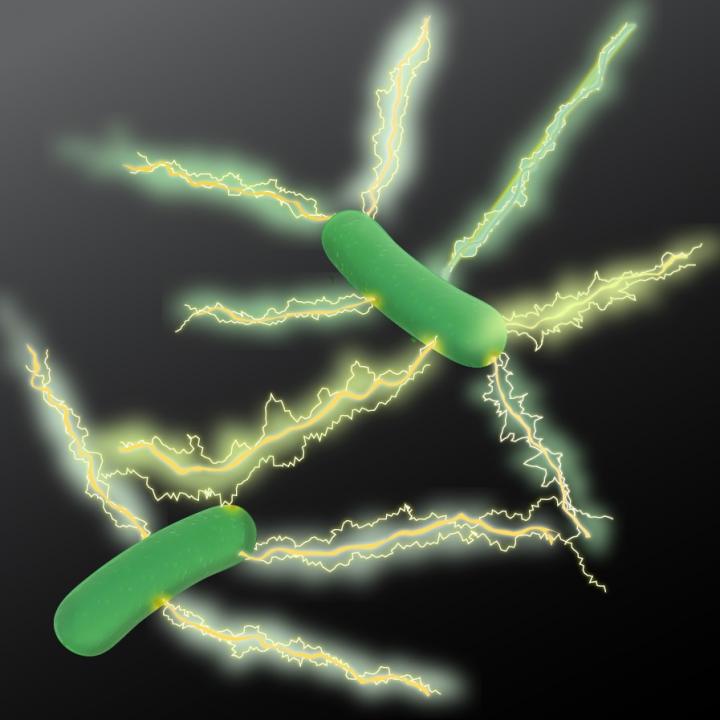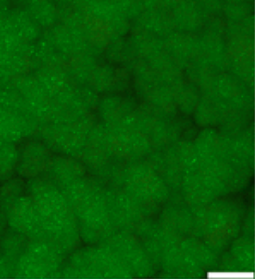Microbiologists make big leap in developing ‘green’ electronics
January 20, 2017

An artist’s rendition of Geobacter expressing electrically conductive nanowires. Microbiologists at UMass Amherst have discovered a new type of natural wire produced by bacteria that could greatly accelerate the development of sustainable “green” conducting materials for the electronics industry. (credit: UMass Amherst)
UMass Amherst research finds microbe yields better electronic material
Microbiologists at the University of Massachusetts Amherst report that they have discovered a new type of microbial nanowire produced by bacteria that could greatly accelerate the development of sustainable “green” conducting materials for the electronics industry.
The study by Derek Lovley and colleagues appears this week in an open-access paper in mBio, the American Society of Microbiology’s premier journal.
A bacterium known as Geobacter sulfurreducens uses the protein filaments naturally to make electrical connections with other microbes or minerals.
As Lovley explains, “Microbial nanowires are a revolutionary electronic material with substantial advantages over man-made materials. Chemically synthesizing nanowires in the lab requires toxic chemicals, high temperatures and/or expensive metals. The energy requirements are enormous. By contrast, natural microbial nanowires can be mass-produced at room temperature from inexpensive renewable feedstocks in bioreactors with much lower energy inputs. And the final product is free of toxic components.”

Confocal scanning laser micrographs of G. sulfurreducens anode biofilms harvested on day 10. Bar, 25 µm. (credit: Yang Tan et al./mBio)
The Microbial nanowires offer an unprecedented potential for developing novel electronic devices and sensors for diverse applications with a new environmentally friendly technology, Lovely says. “This is an important advance in microbial nanowire technology. The approach we outline in this paper demonstrates a rapid method for prospecting in nature to find better electronic materials.”
When his lab began looking at the protein filaments of other Geobacter species, they were surprised to find a wide range in conductivities. For example, one species recovered from uranium-contaminated soil produced poorly conductive filaments. However, another species, Geobacter metallireducens produced nanowires 5,000 times more conductive than the G. sulfurreducens wires. Lovley recalls, “I isolated metallireducens from mud in the Potomac River 30 years ago, and every couple of years it gives us a new surprise.”
In their new study supported by the U.S. Office of Naval Research, they did not study the G. metallireducens strain directly. Instead, they took the gene for the protein that assembles into microbial nanowires from it and inserted this into G. sulfurreducens. The result is a genetically modified G. sulfurreducens that expresses the G. metallireducens protein, making nanowires much more conductive than G. sulfurreducens would naturally produce.
Further, Lovley says, “We have found that G. sulfurreducens will express filament genes from many different types of bacteria. This makes it simple to produce a diversity of filaments in the same microorganism and to study their properties under similar conditions.”
The high conductivity of the G. metallireducens nanowires suggests that they may be an attractive material for the construction of conductive materials, electronic devices ,and sensors for medical or environmental applications. The authors say discovering more about the mechanisms of nanowire conductivity “provides important insight into how we might make even better wires with genes that we design ourselves.”
Abstract of Expressing the Geobacter metallireducens PilA in Geobacter sulfurreducens Yields Pili with Exceptional Conductivity
The electrically conductive pili (e-pili) of Geobacter sulfurreducens serve as a model for a novel strategy for long-range extracellular electron transfer. e-pili are also a new class of bioelectronic materials. However, the only other Geobacter pili previously studied, which were from G. uraniireducens, were poorly conductive. In order to obtain more information on the range of pili conductivities in Geobacter species, the pili of G. metallireducens were investigated. Heterologously expressing the PilA gene of G. metallireducens in G. sulfurreducens yielded a G. sulfurreducens strain, designated strain MP, that produced abundant pili. Strain MP exhibited phenotypes consistent with the presence of e-pili, such as high rates of Fe(III) oxide reduction and high current densities on graphite anodes. Individual pili prepared at physiologically relevant pH 7 had conductivities of 277 ± 18.9 S/cm (mean ± standard deviation), which is 5,000-fold higher than the conductivity of G. sulfurreducens pili at pH 7 and nearly 1 million-fold higher than the conductivity of G. uraniireducens pili at the same pH. A potential explanation for the higher conductivity of the G. metallireducens pili is their greater density of aromatic amino acids, which are known to be important components in electron transport along the length of the pilus. The G. metallireducens pili represent the most highly conductive pili found to date and suggest strategies for designing synthetic pili with even higher conductivities.